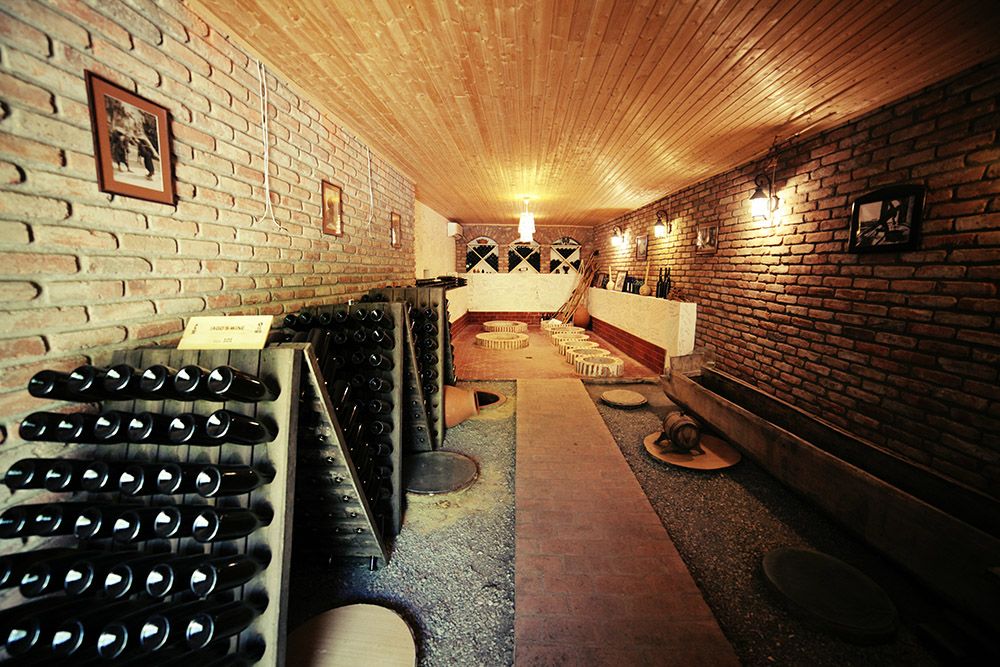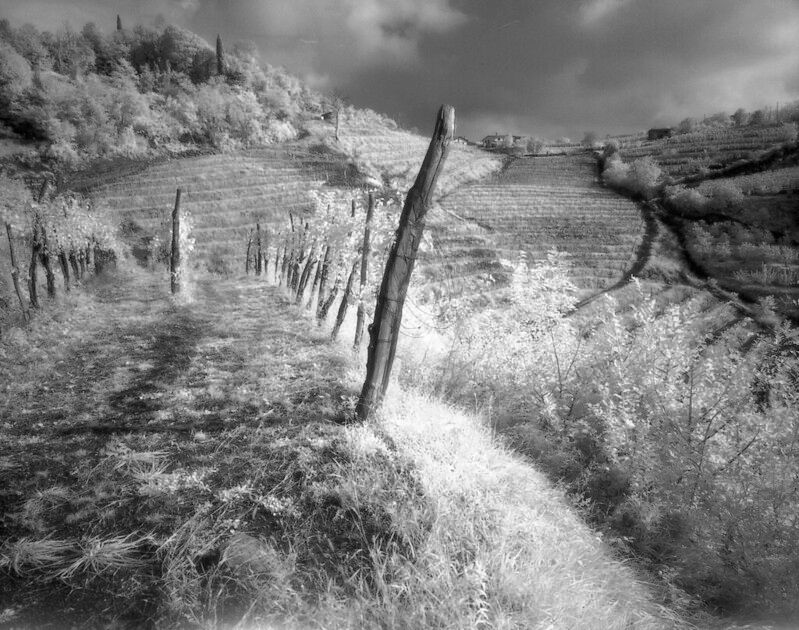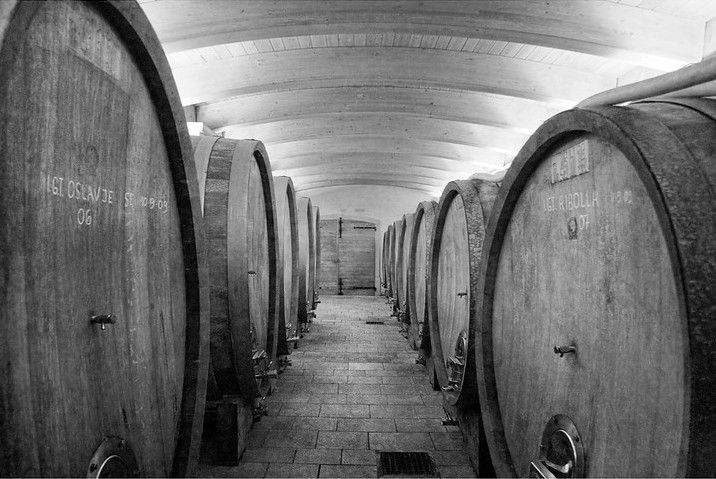
The Complexities of Producing Orange Wines
This article explores the history of orange wines and how they are made today, including interviews with leading winemakers.
12 min read
This in-depth article explores the history of orange wines and how they are being made today, including interviews with leading natural winemakers. For a basic guide to this topic see our article 'What Are Orange Wines?'
Forget the fuss about the name - orange, amber, or perhaps skin-macerated whites. Instead, just imagine yourself gently holding a bunch of white grapes. Peel and taste the skin, slurp the flesh, crunch the seeds.
Orange wines - for that’s what we’ll call them - get their soul from the skin of the grape. This thin protective layer contains a complex array of chemical components including tannins and anthocyanins. All fruits, in fact, share this structure. A peeled apple, for example, tastes surprisingly one dimensional.
In simple terms, orange wines are made from white grapes using a similar method to (most) reds. Instead of quickly squeezing the fruit and fermenting only the juice, the winemaker adds the skins and seeds - and sometimes the stems. The wine is then left to macerate or soak for anything from 24 hours to many months.
As we dig deeper, we soon unearth a fascinating story of the history of wine itself - stretching back nearly ten millennia. “I think orange wine is the first wine - not only in Georgia,” states winemaker Iago Bitarishvili of Iago Winery, who makes all-natural orange wines using the traditional qvevri (kvevri) method in central Georgia. “In the past, maybe all wine was orange. It’s a natural process of vinification.”

His timeless technique - which we’ll explore later - represents one end of the skin-contact spectrum. It involves a lengthy, six-month maceration of whole clusters of grapes, stems and all, in large subterranean clay vessels called qvevri.
But in recent years there’s been an explosion of interest in orange wines around the world. Old traditions have been dusted off and revived; new techniques refined. And a changing, warming climate has inspired a flurry of innovation. This has resulted in a fascinating diversity of maceration techniques and wines of many shades - from pinky yellows to deep ambers.
In this article we’ll meet leading exponents of orange wines, including the Italian winemakers Saša Radikon, Martina Celi and Giulio Armani, Christian Binner in France, Ismael Gozalo in Spain and Craig Hawkins in South Africa.
The term ‘orange wine’ is credited to David Harvey of UK wine importer Raeburn Fine Wines back in 2004. “The quest for a name arose from my concern that there was no name, let alone category for these wines, which are visually, aromatically and structurally divergent from white wines, and would therefore risk rejection in both the on- and off-trades”, he wrote.
In the years since, orange wines have sometimes been derided by some leading lights in the wine trade. Criticisms include a lack of elegance and finesse; or that tannic-heavy macerations mask faults and nuances of terroir.
These accusations would be incomprehensible in Georgia, where orange wines are considered the ultimate expression of a vine. Orange wine is simply wine - it is white and, to a lesser extent, red wines that are the outliers. As Bitarishvilli explains, white wines are described as ‘wines without mother’ as they lack the full embrace of the skin, stems and seeds.
To make his wines, he deploys a series of 22 qvevries of differing sizes which are buried up to their necks in the family cellar. This keeps their temperature consistently cool, which in turn helps to control the fermentation and ageing process.
Bitarishvili harvests his local Chinuri grapes only when fully ripe and the stems fully brown. (Green stems, he explains, have a spicy, green-chlorophyll flavour that are best avoided).

He lightly crushes the whole bunches and tips them into his largest 2,000 litre qvevries, packing the clay vessels three quarters full in order to allow space for the energetic fermentation and production of carbon dioxide.
This first fermentation, spontaneously triggered by wild yeasts on the skins and stems, lasts around two weeks. Using a wooden stick, Bitarishvilli punches down the grapes several times each day to promote maceration by rotating and submerging the grapes. This also helps to reduce the fermentation temperature, which is highest towards the top.
Once fermentation is complete, he tops up the qvevri from another. (He starts off with eight large qvevries, which ultimately become five - the remainder contain only used skins and stems.) This topping-up process prevents the potential oxidation of the wine once the carbon dioxide has dissipated.
The wine then undergoes a subsequent malolactic fermentation, which lasts around four weeks. Bitarishvilli then seals the qvevries and allows the contents to macerate for a further two months.
During this final stage, the skin and stems slowly float to the bottom of the qvevri in a natural process of filtration. Bitarishvilli then pumps the clear orange wine into smaller qvevries for storage and ageing.
The winemaker says: “Longer maceration means many different ingredients go from the skin into the wine - phenols and tannins. These work like natural conservants so we have a stable wine. We don’t need to use sulfur - or just a little bit.”
This all-natural qvevri method is both simple and highly complex. “I don’t sleep for two months before harvest,” admits Bitarishvili, as he details the labor-intensive process of climbing into the large qvevries to clean them with ash, limestone and brushes made from the bark of wild cherry trees. “All Georgian people who make qvevri wine are very skinny,” he jokes.
"One of the biggest mistakes is making the harvest in the same way as white wines" (Saša Radikon)
In the north of Italy, on eight hilly hectares close to the Slovenian border, winemaker Saša Radikon confirms the importance of using only fully ripe grapes to make orange wines.
“One of the biggest mistakes is making the harvest in the same way as white wines. If the tannins are ripe we can have longer skin contact without any problems,” he states.
It was Saša’s father, Stanko, that helped to pioneer the renaissance of orange wines in northern Italy. He was a key member of a group of winemakers in Friuli who began experimenting with skin contact in the mid 1990’s. Josko Gravner was another, who began his trials by importing a small Georgian qvevri. He now makes all of his wines using this amphora method.
Macerated white wines were nothing new in this part of Europe. For their grandfathers’ and earlier generations, a degree of skin contact helped to preserve their wines. It was the advent of more modern machinery - especially presses - that dramatically changed how white wines were made.
In 1995, Radikon switched his entire production of Ribolla Gialla to seven-day skin contact - and lost many customers as a result. It took years to painstakingly rebuild the business but his family’s orange wines are now considered to be among the very best in the world.
In the vineyard, Radikon’s team ruthlessly thin the emerging clusters during growing season, with yields as low as one bunch per vine. “In our climate we have a lot of rain during the harvest,” he explains. “We have a very short season and we prefer to produce less grapes to have them completely ripe.”


Radikon vineyards and cellar. Credit: Radikon
He cultivates a mixture of indigenous Ribolla Gialla along with Malvasia Istriana, Friulano, Pinot Grigio, Chardonnay and Merlot. Before harvest, he walks the rows tasting the grapes - sampling the skin and seeds separately. “The skins should have a good sweet taste and you should have some tannins. The seeds have to be completely brown, the tannins inside completely ripe.”
Unlike the qvevri method in central Georgia, Radikon does not macerate the stems. (In the Friuli climate, he says, “it’s almost impossible” for the stems to fully ripen). During fermentation, he also uses a wooden staff to “punch down” the skins as they float to the top, which helps to control the fermentation temperature and maximise extraction.
After fermentation, he then seals the wine in large wooden barrels rather than clay vessels for a further cold maceration over a total of three months. At this stage, the alcohol in the wine helps with a further prolonged phase of gentle extraction. “We have another kind of extraction - basically an infusion,” Radikon says.
"The quality of the grape is in the skin and not in the juice" (Giulio Armani)
Giulio Armani at Azienda Agricola Denavolo and La Stoppa has experimented with maceration techniques for decades, beginning with early experiments using ‘cold maceration’, a process where you crush then seal the grapes prior to fermentation.
He no longer uses this method and now believes the key to successful orange wines is to allow the wine to macerate with the lees after fermentation. He adds: “I think it’s better to arrive almost dry, to have the alcohol that extracts the tannins and all these very interesting things for the wine”.
His Ageno from La Stoppa is a flagship wine with a four-month maceration. “In 2001, I tried to do skin maceration without sulfites and adding nothing at all with some typical grape varieties of the region like Malvasia, Ortrugo, Trebbiano. I realised then that we could do very good things within a year. It was during the 2002 harvest that Ageno was born.”
Over his long career, Armani has made many white wines using standard direct pressing but has now turned his back on this approach. “The quality of the grape is in the skin and not in the juice. The juice is almost nothing and you must have time to extract the interesting part that is in the skin.”
Radikon agrees that long macerations increase complexity but believes this must be balanced with extended ageing: three years in large oak barrels to help round out the wine, then a further year in bottle.
His wines are remarkable in terms of their age, typically released to the market five years after harvest and with great potential for further ageing. But for a typical winemaker, an extended process like this puts pressure on both limited cellar space and income flow. “If you make a shorter skin contact you can sell the wines a bit earlier,” Radikon says.
In the Alsace, Christian Binner also embraces lengthy skin contact. He makes a variety of orange wines including his pink-hued Cuvée Si Rose, an equal blend of two vintages of Gewurztraminer and Pinot Gris - one macerated for eight months, the other for eight days - before one year of ageing in 100-year-old oak barrels.
“A long maceration gives a lot of complexity and length,” Binner says. “Sometimes it's a bit too tannic, too much extraction, but with the ageing I think that gives really crazy wines.”
Binner believes that aromatic varieties are ideal for skin contact, adding much-needed character to the grape. (“Gewurztraminer in direct pressing in white is such a boring wine,” he sighs).
His next plan is to build a solera system, allowing him to systematically mix old and newer vintages of orange wine in the same way as some sherries.
The climate in Alsace is changing, as summers become more warm and dry. Binner is working hard to adapt, using techniques from agroforestry and biodynamics to preserve humidity in the soil, which is essential for fully ripening his grapes for successful maceration.
In the high plains of central Spain, winemaker Ismael Gozalo Palomo at Microbio Wines is well accustomed to working in sizzling hot summers. He makes orange wines in a similar manner to Bitarishvilli but using ’tinajas’, large clay jars traditionally used in Spain.
“We can get 40C in summer so it’s very easy to lose the freshness in the grapes.” He cools the fruit and juice before fermentation. “We never press above 12 degrees.”
Palomo makes several styles of orange wine - one with stems, another without - and works with ancient Verdejo vines. “For us, young vines are 140 years old and the oldest vines are like 273 this year.” After fermentation, he leaves the wine to macerate for up to nine months in the tinajas before racking off into old oak barrels.
Heat is also an issue for Craig Hawkins at Testalonga in Swartland. He’s a pioneer of orange wines in his country, typically made with Chenin Blanc. His journey began with many years travelling around Europe, helping to bring in the harvest.
Hawkins now makes orange wines from around 20 hectares of organic vineyards in the Western Cape. “South Africa is definitely more suited to skin contact purely because we have such high intensity of the sun’s radiation. The skins are a lot thicker here, a lot more golden.”
For him, these conditions mean he has ample tannins at his disposal when it comes to judging the duration of maceration. “The tannin gives you the colour, it stabilises the wine, it helps it to age a lot longer. If you start with high tannins in the grapes you can always work back and get less - but it’s very difficult to get more.”
He adds: “I always struggled with South African wines because I thought that from vintage to vintage they all tasted the same. There were very particular orange wines that made me kind of wake up. It was my epiphany moment.”
He recalls his first mind-blowing taste of a skin macerated Vermentino from a winemaker called Antonio Perrino. “It was orange. It was meant to be a white wine but it's not. It had tannin. It had colour. It had everything I was looking for. It spoke of something that I hadn’t felt before.”
Hawkins prefers little or no stems (perhaps 5-10%) for his maceration and often ages in old oak foudre. “I love acidity. I'm looking for tension in a wine, something that makes you thirsty after you take the first sip, something that wants you to keep on drinking.”
Bubbles are another feature of this new wave of orange wines. In the Veneto region of Italy, Costadilà have been resurrecting the ‘vin con il fondo’ (or ‘vin col fondo’ or ‘wine with sediment’) method of making skin-contact sparkling wines with a second fermentation in bottle.
Modern mass-market prosecco is made without maceration. The wine undergoes a second fermentation in large metal tanks called ‘autoclave’ with added sugar and yeast before filtering under pressure and bottling with no sediment.
Rewind more than 40 years, however, and farmers would typically harvest their grapes, sell the bulk to a cooperative but keep back a portion for their own supply.
Local grape varieties such as Glera and Verdiso are light in body and low in alcohol. “They would make some base maceration to give the wine more structure and add the polyphenols from the skin,” explains Martina Celi who, along with Alex della Vecchia, has taken over the project since the death of founder Ernesto Cattel.
After a first fermentation, the team at Costadilà store the wine until spring then add must or the sugars from carefully dried grapes, saved from the previous year, to kickstart a second fermentation in bottle.
Although there is a growing thirst for orange sparkling wines, they are firmly off the menu in some regions. In Champagne, for example, it is forbidden to macerate the grapes although some winemakers secretly experiment below the radar.
Back in Alsace, however, Christian Binner relishes the idea. “It would be funny to make a bubbly orange wine. Why not? For me, orange wine gives more complexity and power and a deep and large mouthfeel. I could imagine macerating the Gewurztraminer before and then make a pet nat. Now that’s an idea."
"I can't put ‘Orange Wine’ on the label because it's forbidden" (Giulio Armani)
These issues around the classification and labelling of orange wines remain a serious issue for many winemakers. In Italy, they are unable to put these two words on the bottle. “At the moment the law only allows us to put ‘White Wine’. So I can't put ‘Orange Wine’ on the label because it's forbidden,” explains Guilio Armani.
Hawkins recalls a traumatic period when attempting to export his first bottlings of skin-contact Chenin. To gain export approval in South Africa, all new wines are blind tasted by a panel at the Wine and Spirit Board. His wines failed three times in a row. It was only by threatening to sue - and providing scientific proof that his wines were not oxidised - that Hawkins eventually received the green light.
As demand surges for orange wines, this theme of regulation and classification will become more vital than ever. When browsing for a bottle on the shelf, consumers may well presume that every orange wine is, by an extension, a natural wine. But large, conventional wineries have sniffed a commercial opportunity. The fight is on to preserve the ancient soul of orange wines.
Continue exploring
You can find out more about the growers / makers featured in this article by exploring the links below (order is alphabetical). Happy adventuring!
- Christian Binner Wines and Interview
- Costadila Wines (Martina Celi)
- Denavolo Wines and La Stoppa Wines (Giulio Armani)
- Iago Winery Wines and two interviews His Philosophy and Master of the Qvevri (Iago Bitarishvili)
- Microbio Wines and Interview (Ismael Gozalo)
- Radikon Wines and Interview (Saša Radikon)
- Testalonga Wines and Interview (Craig Hawkins)


